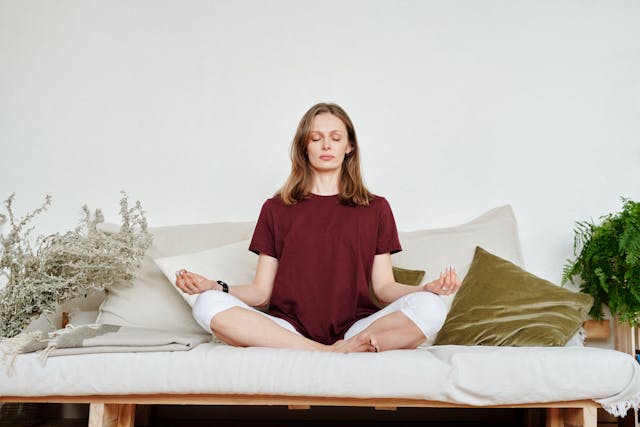Amidst all this, mindfulness meditation for anxiety has emerged as an effective and simple solution. It not only reduces anxiety but also brings peace and balance to the mind and body.
In today’s fast-paced and stressful world, anxiety has become a common problem. Whatever the reason, the effects are usually the same: restlessness, nervousness, and a mind full of worries. People of all ages face anxiety in some form or another. It could be due to work pressure, family responsibilities, study stress, or worries about an uncertain future.
What is Mindfulness Meditation?
Mindfulness means “being fully aware and conscious in the present moment.” Mindfulness meditation is a practice where a person observes their thoughts, feelings, and physical sensations without any judgment. The goal is not to stop your thoughts but to notice them without reacting or judging them.
How Does Mindfulness Affect Anxiety?
Anxiety is often caused by fears and worries about the future. We either get stuck in past events or worry about the future. Mindfulness meditation helps us practice living in the ‘present moment’, which frees us from past regrets and future worries.
When we are fully present, our anxiety naturally decreases. It balances the chemical changes in the brain, reducing stress hormones (like cortisol) and increasing happiness hormones (like serotonin).
How to Practice Mindfulness Meditation?
Mindfulness meditation is very simple and can be done anytime, anywhere. Here are some easy steps:
- Choose a Quiet Place: Sit in a quiet place where you won’t be disturbed for a while.
- Sit Comfortably: You can sit cross-legged on the floor or on a chair, but keep your back straight.
- Focus on Your Breath: Close your eyes and take slow, deep breaths. Feel the natural flow of your breath as it comes in and goes out.
- Let Thoughts Come and Go: Thoughts will come during meditation; this is natural. Don’t try to stop them. Just observe them without any reaction or judgment, and gently bring your focus back to your breath.
- Ending the Meditation: Slowly open your eyes and take a moment to feel the peace within.
Focus on Your Breath: The Foundation of Mindfulness Meditation
In mindfulness meditation, “focusing on the breath” is one of the most important and effective practices. It not only brings the mind to the present moment but also significantly reduces anxiety and stress. Our breath is always with us, and we can observe it without controlling it, making it the perfect object for meditation. Let’s understand this in detail.
What Does It Mean to Focus on the Breath?
Focusing on the breath means observing the process of breathing in and out without trying to change or control it. You don’t try to make your breath longer or deeper; you just feel it as it naturally is.
- When you breathe in, air enters through your nose and goes into your lungs.
- When you breathe out, the air leaves your body.
- Simply watching this natural flow is what focusing on the breath is all about.
How to Focus on the Breath?
1. Find a Comfortable Position:
- Sit in a quiet and clean place.
- You can sit cross-legged on the floor or on a chair.
- Keep your back straight but your body relaxed.
- Rest your hands on your lap or knees.
2. Close Your Eyes:
- Closing your eyes helps reduce distractions.
- If you prefer to keep your eyes open, softly gaze at the ground.
3. Feel Your Breath:
- Bring all your attention to your breath.
- Notice how the air enters your nose and leaves it.
- Feel the slight touch of air in your nostrils and the rise and fall of your chest or belly.
4. Accept the Natural Rhythm of Your Breath:
- Whether your breath is long or short, deep or light, don’t try to change it.
- Just observe it as it is.
5. Let Thoughts Come and Go:
- During meditation, thoughts will come, like—“I have work to do,” “Am I doing this right?” or “How much time has passed?”
- Don’t try to forcefully stop these thoughts.
- Observe them like an outsider and gently bring your focus back to your breath.
6. Use Counting (Optional):
- If your mind keeps wandering, you can practice counting with your breath.
- Say “one” when you breathe in and “two” when you breathe out.
- Count up to five or ten, then start again from “one.”
- This helps keep your attention on the breath.
Benefits of Focusing on the Breath
– Calms the Mind:
The steadiness of the breath brings steadiness to the mind. It reduces anxiety and stress, bringing a sense of peace.
– Brings You to the Present Moment:
When you focus on your breath, your mind is free from regrets of the past and worries about the future, bringing you fully into the present.
– Improves Concentration:
Focusing on the breath enhances concentration and mental clarity, helping in better decision-making.
– Emotional Balance:
It helps you understand and manage your emotions, giving you control over negative feelings like anger, fear, and frustration.
How to Start?
- Begin with just 5 to 10 minutes.
- Gradually increase to 20-30 minutes.
- Practice regularly, even if it’s just once a day.
Things to Keep in Mind
- Stay Relaxed: Don’t take any pressure while focusing on your breath. Let it happen naturally.
- Be Consistent: Just as regular exercise strengthens the body, regular meditation strengthens the mind.
- Acceptance and Patience: Your mind will wander many times, but accept it and patiently bring your focus back to your breath.
By regularly practicing mindfulness meditation with a focus on the breath, you can experience reduced anxiety, enhanced concentration, and a balanced emotional state. It’s a simple yet powerful way to bring peace and calmness to your life.
Other Benefits of Mindfulness
- Reduces stress
- Brings mental peace and clarity
- Improves concentration and memory
- Balances emotions
- Enhances sleep quality
Consistency is Important
The benefits of mindfulness meditation are experienced only when practiced regularly. Just like exercise is necessary for physical health, meditation is necessary for mental health.
Conclusion
Anxiety is a natural human experience, but it can be managed. Mindfulness meditation is a simple and effective way to reduce anxiety without any side effects. It teaches us to live in the present moment, freeing us from past regrets and future worries. If practiced regularly, it can become a source of peace and happiness.





